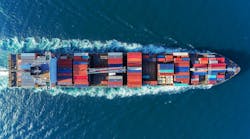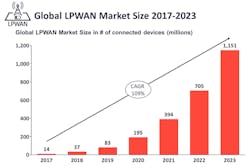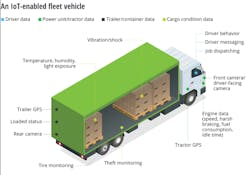Real-time, transparent, and seamless tracking of assets, both indoors and out, while optimizing logistics and supply chains, has long been the focus of innovative companies around the globe. Internet of Things (IoT) technology is on the cusp of ushering in a whole new era of end-to-end supply-chain monitoring and actionable analytics. In particular, the recent emergence of low-power, wide-area networks (LPWANs) is driving this transition.
As the volume of goods transported globally continues to rise, organizations face greater complexity but also more opportunities to optimize their supply chains. The Council of Supply Chain Management Professionals’ annual State of Logistics report found that in 2017 in the U.S. alone, total spending on logistics rose to a record of nearly $1.5 trillion. That’s up 6.2% from the year before, and totaling about $250 billion more than companies spent on logistics in 2008.
Analyst firm Berg Insight reports that the number of active tracking devices deployed for cargo-loading units, including trailers, intermodal containers, rail freight wagons, air cargo containers, cargo boxes, and pallets, reached 6.1 million worldwide in 2018. Growing at a compound annual growth rate (CAGR) of 27.3%, this number is expected to reach 20.4 million by 2023.
The highly diverse supply chain spans a wide range of different attributes and requirements, requiring intercontinental and global solutions. Routine activity encompasses everything from the shipping of large products from factories to distributors and customers to the minutiae of ensuring the tiniest parts arrive punctually at just-in-time production lines.
Supply-chain management also is at the heart of the retail sector: Ensuring stock is available and swiftly dispatched to customers or stores is integral to ensuring the right equipment is in the right place and in the right condition to enable the activities of many other industries.
As economies combat the COVID-19 pandemic, it will take even greater visibility into supply chains to enable factories that depend on just-in-time delivery of goods to reopen and adapt to new operational requirements.
Supply-Chain Management Demands Greater Visibility
Because traditional patterns can no longer be relied on, facilitating decision-making by providing timely data that can be analyzed and acted upon is a vital capability for manufacturers, retailers, and distributors. Deloitte’s “Global Chief Procurement Officer Study 2018” found that only 6% of organizations have full visibility into their supply chain, and 65% of organizations have poor or no visibility beyond their tier-1 suppliers.
To gain further knowledge of their supply chains, organizations need connectivity to freight transport down to the individual package or parcel. Besides being cost-effective, connectivity must be set up rapidly, flexibly, and simply so that networks can be turned on, moved, or switched off as required. In addition, there must be a vibrant developer ecosystem to create the devices and applications around the connectivity that enable data to be gathered and analyzed to deliver actionable insights.
LPWAN Technology Transforms Supply-Chain Management
LPWANs enable low-cost wireless connectivity that makes it viable to add connectivity to lower-value assets as well as traditionally tracked equipment like trucks, shipping containers, and rail freight. The price point means individual lower-value items (or packages of them) can be tracked at a sustainable cost and at enormous volume. In such scenarios, LPWANs can communicate important data for analysis that yields actionable insights into the location, condition, and predicted arrival time of assets.
In Figure 1, analyst firm IoT Analytics projects LPWAN connections will exceed one billion in 2023. In contrast to short-range solutions such as Bluetooth and Zigbee, which provide a good solution for hyper-local tracking and tracing of assets, LPWAN connectivity can be enabled many miles from the nearest gateway, thereby covering large industrial sites.
Cellular solutions, which are near-ubiquitous, are more complex to manage globally. They require roaming agreements between multiple providers and often necessitate adoption of multiple technologies across the GSMA stack of protocols. 4G and 5G are not fully rolled out and, where available, remain relatively costly solutions for low-value asset tracking both in terms of connectivity and module cost.
Satellite solutions offer excellent global coverage and are ideal for tracking higher-value, larger assets. In these cases, the higher cost of satellite connectivity makes sense and the larger device size, including antennas, can be more easily accommodated. An example might be a truck or a shipping container. However, for smaller packages, the power requirements, antenna size, and cost make satellite-based approaches unsuitable.
LPWAN Isn’t One-Size-Fits-All
The LPWAN tag describes a number of different technologies that have low-power, wide-area attributes. This field is becoming increasingly crowded with options such as narrowband IoT (NB-IoT), Sigfox, and LoRaWAN, each of which must be carefully evaluated for the application at hand.
LoRaWAN specifically is an excellent fit because it brings together competitive cost with the capability to handle extremely high device density at a given site. Think of a logistics facility with the tens of thousands of containers, assets, and parcels that traverse it daily. The ability to have deep indoor coverage, which is vital inside the large warehouses that form the core of international logistics, some of which involve underground capacity, is extremely valuable. LoRaWAN can penetrate these large buildings, ensuring uninterrupted asset tracking.
At these facilities, LoRaWAN offers the option of public or private networks, which is attractive to large site operators because it can drive economies, assure performance, and is perceived to be highly secure. In either type of deployment, it’s worth noting LoRaWAN’s mature security, which been developed over many years.
A further strength of LoRaWAN devices is their typically very long battery life. It makes them ideal for multiple long journeys, such as for the months involved in intercontinental shipping, or for more complex applications like daily updates on the location and status of a truck (Fig. 2).
Asset tracking isn’t performed in controlled environments and logistics, and by its nature involves shock, vibration, temperature extremes, and other factors otherwise not present in smooth, non-mobile environments. LoRaWAN is rugged, so it can continue to operate in most extreme situations.
How LoRaWAN Delivers Supply-Chain Benefits
LoRaWAN provider Semtech has supplied a car manufacturer with connected racks used in the vehicle-manufacturing process. These racks, which typically have an active life of 10 years, are used to transport key components such as gearboxes from their point of manufacture to the assembly plant. These racks cost about €500 and manufacturers use hundreds of thousands of them. Approximately 10% are replaced each year, resulting in €10 million in operating expenditures.
Semtech also has supplied Pallet Alliance, a provider of pallet-management programs for multi-site organizations, with its IntelliPallet, an IoT-based pallet-monitoring platform. The platform integrates location and environmental sensors into wooden pallets, which comprise more than 90% of the worldwide palletized shipping market. The flexible LoRaWAN-based platform offers customized tracking capabilities, including entry and exit notifications from a geo-fenced area, stationary time and arrival/departure from designated hubs, and environmental monitoring for factors including temperature, humidity, and motion.
Another LoRaWAN supply-chain example can be found at United States Cold Storage (USCS), a provider of public refrigerated warehousing (PRW) and logistics services. The company wanted to offer enhanced visibility into shipments of perishable goods as part of its integrated third-party logistics service offering.
LoRaWAN network operator Senet and NanoThings—a developer of long-range, temperature-tracking smart labels and a platform to monitor temperature and manage cold chains with inter-company communication—have partnered to combine the affordability and small form factor of NanoThings’ NanoTags with LoRaWAN network connectivity to address USCS’s needs. The partners provide customers with autonomous temperature monitoring and touchpoint tracking that could transform how data on perishable goods is collected and used throughout the retail supply chain.
The Connected Supply Chain of the Future
LoRaWAN and other LPWA technologies imbue supply-chain management with the power to continuously connect items in transit and cost-effectively monitor them globally for the lifespan of the device. These capabilities have the potential to radically transform the industry. To date, visibility has been obtained by tracking large assets such as shipping containers, trucks, or rail wagons. LPWANs open the next stage of opportunity by enabling connectivity down to the individual item to be viable.
This isn’t a high-bandwidth, multimedia experience. Rather, it’s the simple transmission of data, robustly and securely, that can feed supply-chain management systems with a flow of accurate data that informs important decisions. Its value will be proved in increased efficiency, greater accuracy, and fewer failures because of lost assets or spoiled goods.
Pierre Gelpí is Logistics Marketing Group Chair for the LoRa Alliance and LoRa Business Development Director at Semtech.


